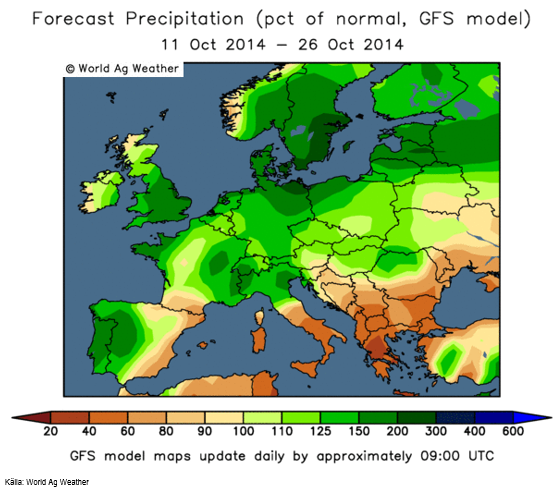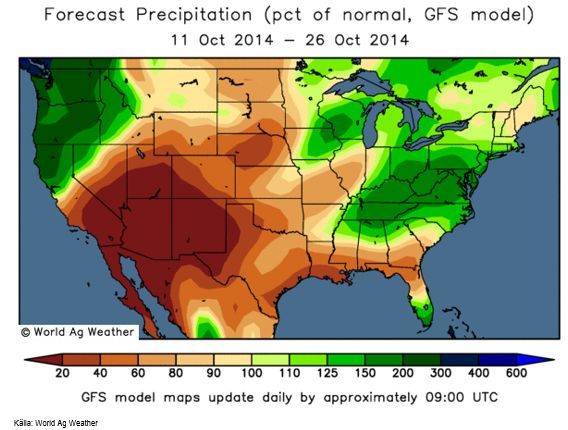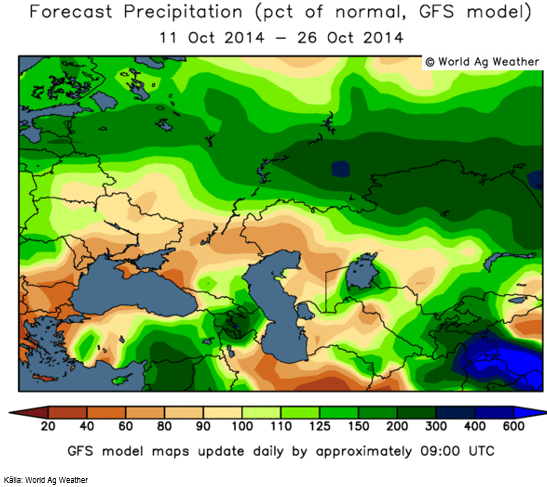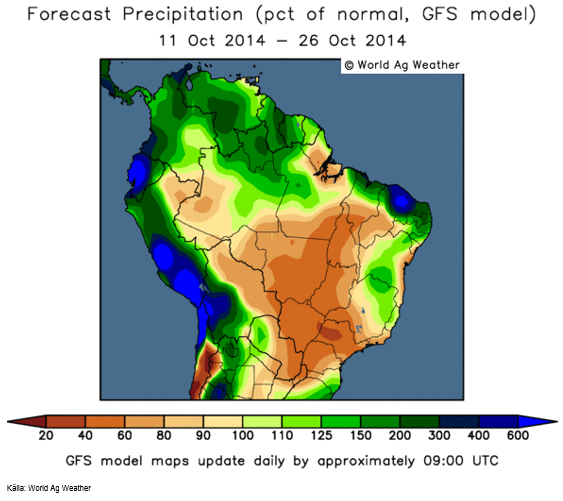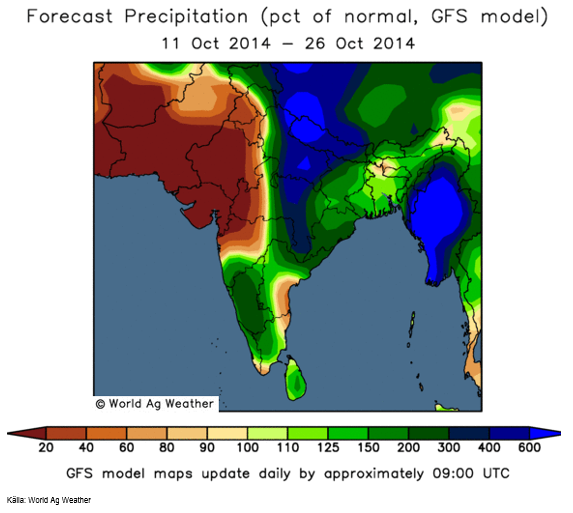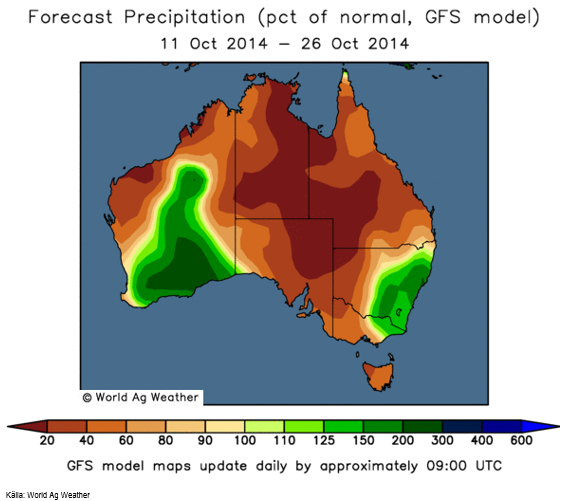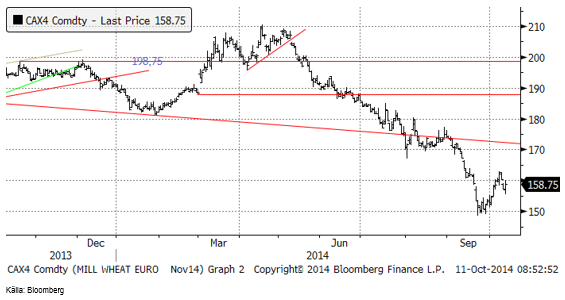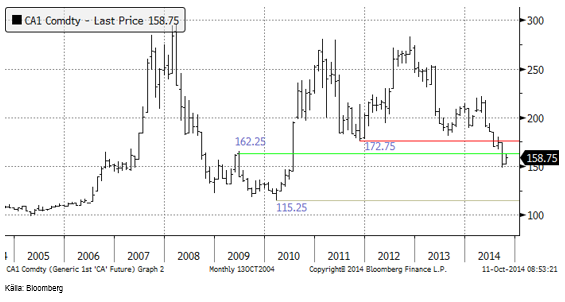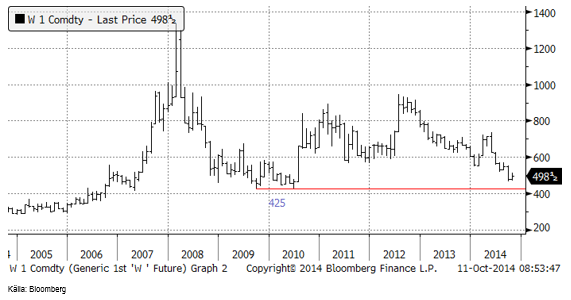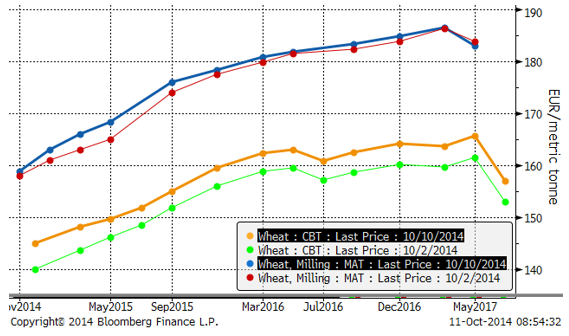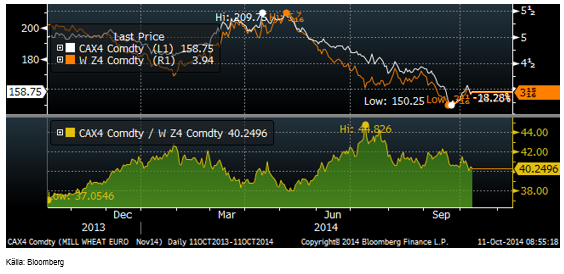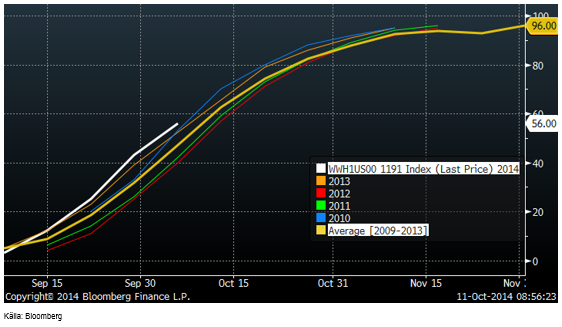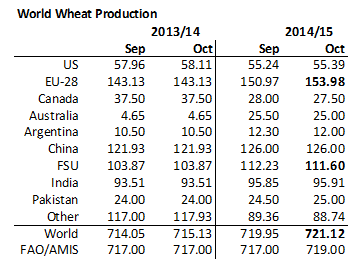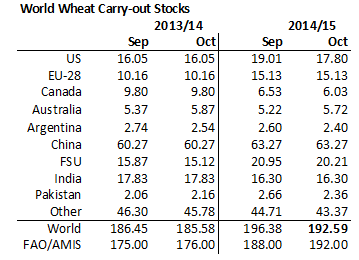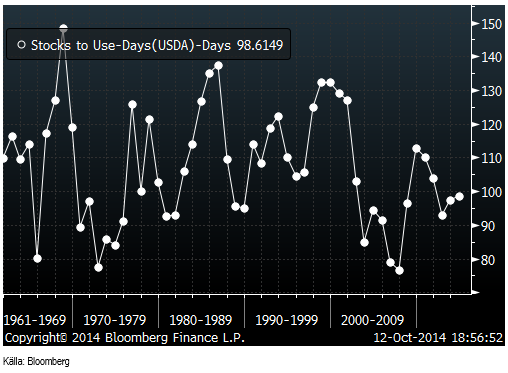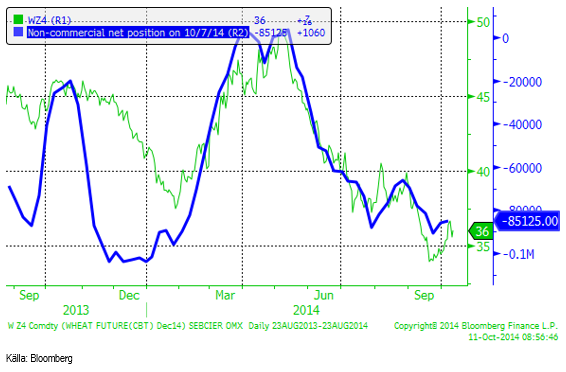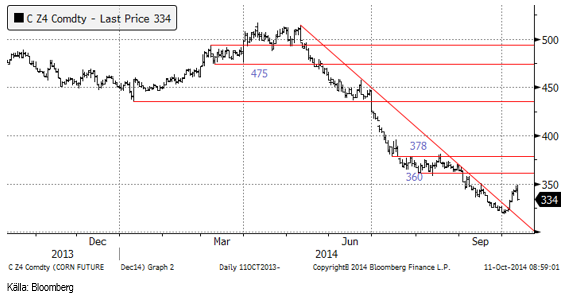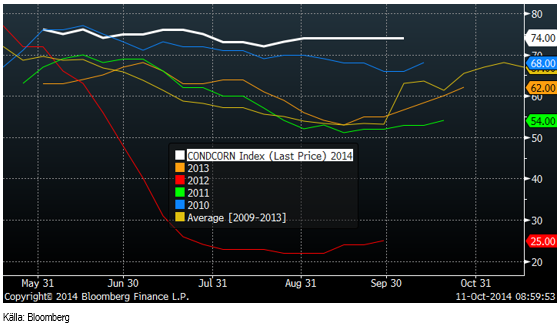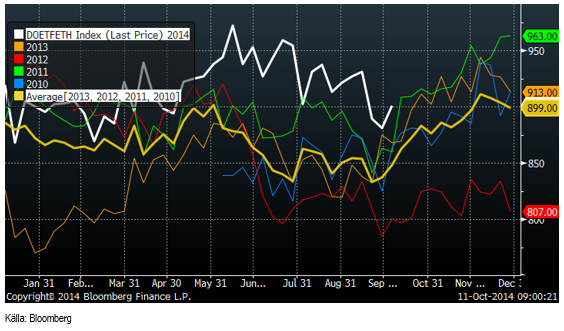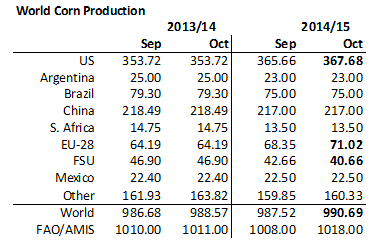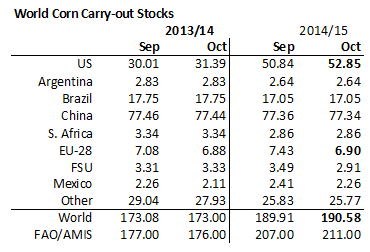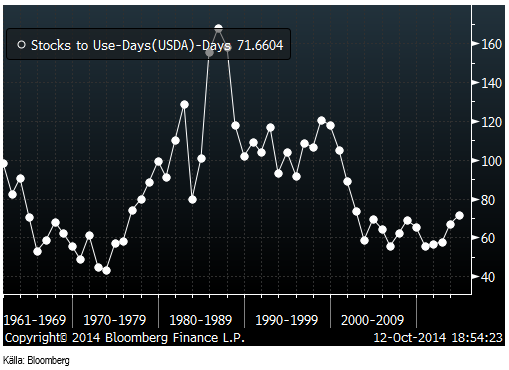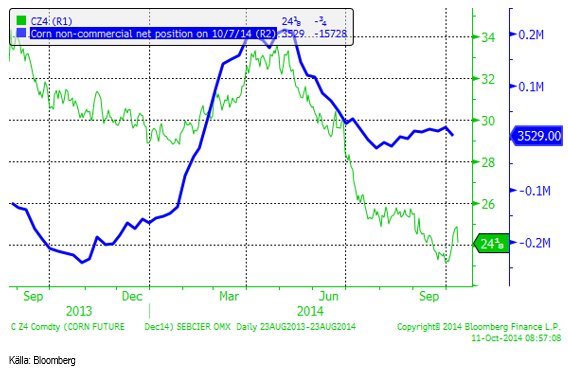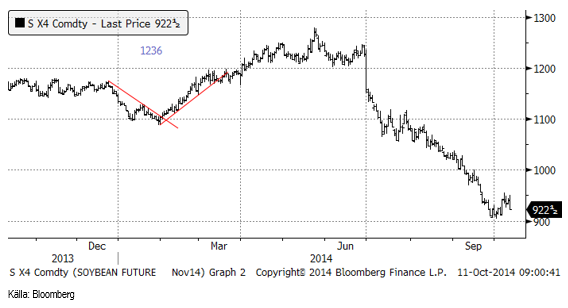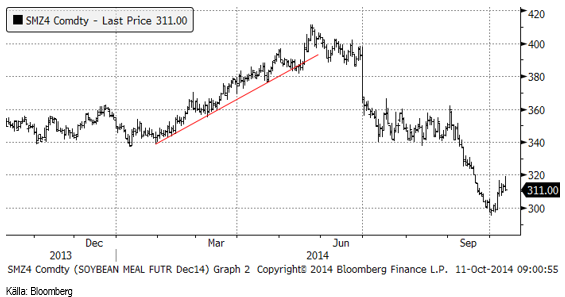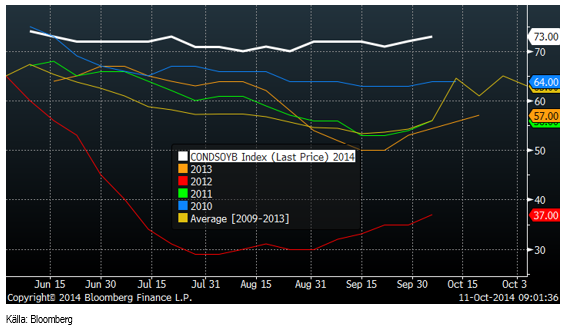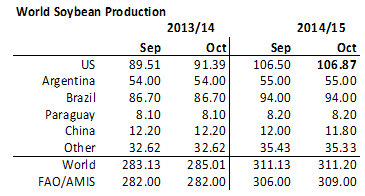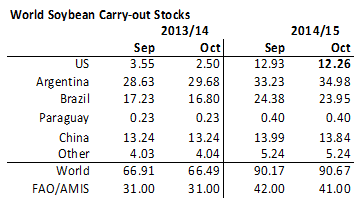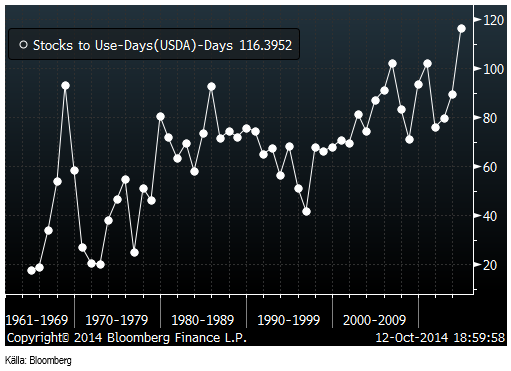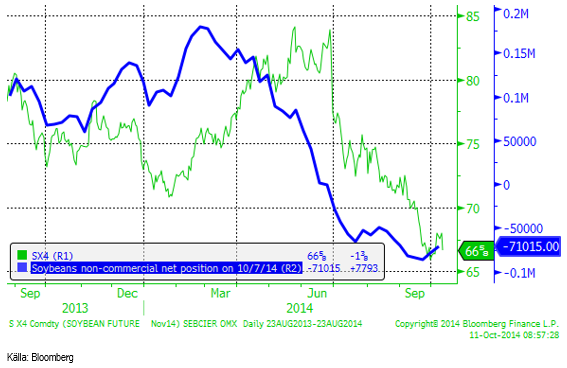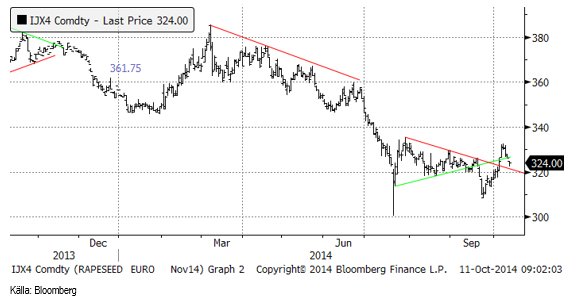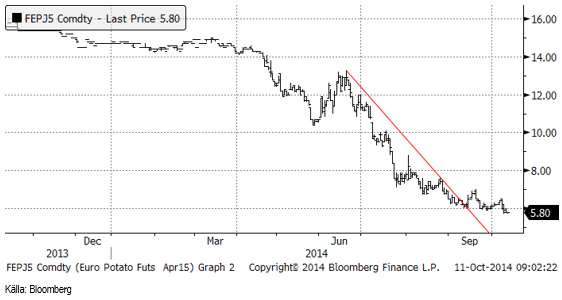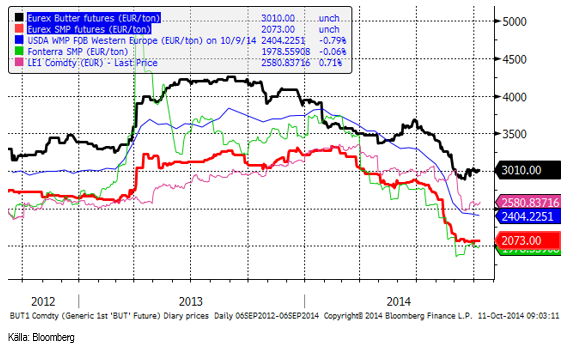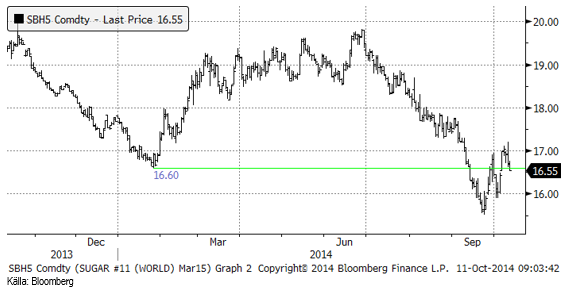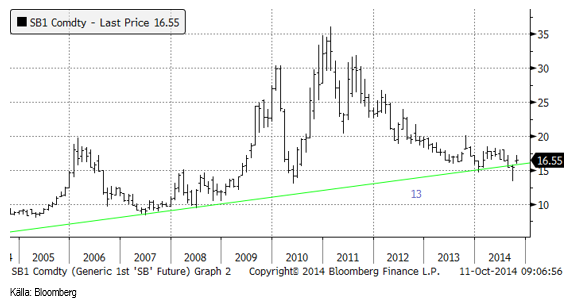Analys
SEB Jordbruksprodukter, 13 oktober 2014


 Det skedde en allmän återhämtning i priserna för spannmål och oljeväxter förra veckan. Sojamjöl, majs och vete steg med mellan tre och fyra procent. Både FAO / AMIS och USDA publicerade sina månadsvisa uppdateringar av sina estimat för produktion, konsumtion och utgående lager. Det var lite blandad kompott. Man kan tolka WASDE-rapporten som positiv för Chicagovete, men negativ för Matif. För majs var det negativt, men priset är så lågt att man måste börja ta hänsyn till hur populärt det kommer att vara att så majs nästa år och vilka konsekvenser det kan få på utbudet. För sojabönor var det en negativ rapport också, även om utgående lager i USA sjunker. Globala lager är på den högsta nivån sedan åtminstone 1961.
Det skedde en allmän återhämtning i priserna för spannmål och oljeväxter förra veckan. Sojamjöl, majs och vete steg med mellan tre och fyra procent. Både FAO / AMIS och USDA publicerade sina månadsvisa uppdateringar av sina estimat för produktion, konsumtion och utgående lager. Det var lite blandad kompott. Man kan tolka WASDE-rapporten som positiv för Chicagovete, men negativ för Matif. För majs var det negativt, men priset är så lågt att man måste börja ta hänsyn till hur populärt det kommer att vara att så majs nästa år och vilka konsekvenser det kan få på utbudet. För sojabönor var det en negativ rapport också, även om utgående lager i USA sjunker. Globala lager är på den högsta nivån sedan åtminstone 1961.
Även CONAB levererade estimat för Brasiliens kommande odlingssäsong och det var ytterligare en GASC.
Tysk ekonomisk statistik fortsätter att utvecklas svagt. Förra veckan var det IFO:s affärsklimatindex och den här veckan svag export. IMF sänkte utsikterna för global tillväxt i veckan. Eurozonen går mot recession.
Odlingsväder
Det extra nederbördsrika vädret över Europa väntas fortsätta i två veckor till. Som vi ser får nu även östra Europa mer nederbörd än normalt.
Prognoskartan för nederbörden i USA visar torrt väder i ’corn belt’ och blötare typiska veteodlingsområden som Kansas och Oklaholma.
Förra veckans extremt torra prognos för Ryssland, Vitryssland, Ukraina och västra Svarta Havskusten ser nu ut att få mer nederbörd.
I Brasilien har den extremt torra prognosen fått ge vika för mer normal nederbörd. Minas Gerais norra delar väntas få något över normal nederbörd. Mato Grosso, den stora sojaprocenten, väntas få 60-80% av normal nederbörd, vilket är väsentligt bättre än 0 – 40%, som förra veckans prognoskarta sade.
Indiens monsun fortsätter att vara mindre intensiv än normalt. Särskilt besvärande måste det vara i nordvästra Indien, som sett likadant ut i över en månad.
Australien som förra veckan väntades få nederbörd endast i South West, får nu regn inte bara där, utan även i sydvästra delen av landet.
Vete
Vetepriset (novmeberterminen på Matif) steg i fredags på WASDE-rapporten. Den tolkades initialt som positiv, men detta vände sedan under kvällen till negativt, efter att Matif stängt.
Socomac-silon fylldes också upp i veckan, och nu är alltså både Senalia och Socomac fyllda och tar inte emot leveranser. Dessa är leveranspunkter för terminerna på Matif-vete. Hur det kommer att gå att stänga novemberkontraktet på Matif när det finns ett stort incitament att leverera ut vete i och med stängningen, vet ingen. Vi tror det är säkrast att man tar sig ur Matif:s novemberkontrakt i god tid innan leverans.
Det ryska jordbruksdepartementet rapporterade i veckan att mer än 100 mt spannmål har skördats, med 10% av åkerarealen kvar att skörda. De rapporterade också att 78% av höstsådden är klar på 12.9 mHa jämfört med 8.7 mHa förra året. Sådden sker dock i ganska torr jord.
I nedanstående diagram ser vi hur Matifs ”spotkontrakt” utvecklat sig de senaste tio åren. Priset är på en nivå som tidigare varit bottennivåer. Därmed ska man inte utgå från att priset vänder upp från den här nivån genast. Tidigare har priset stannat på en låg nivå i flera månader, innan det vänt upp igen.
Chicagovetet (december) har en liten bit kvar på nedsidan innan marknaden rör vid ett starkt stöd.
Nedan ser vi terminskurvorna i fredags och en vecka tidigare för Matif respektive Chicago. Det är contango på båda marknader.
Matifs novemberkontrakt håller sig i samma relation som tidigare till Chicagos decemberkontrakt.
Sådden av höstvete har avancerat från 43% färdigt förra veckan till 56% den här veckan.
FAO, som rapporterade i torsdags, dagen innan USDA:s WASDE-rapport, höjde det globala produktionsestimatet för 2014/15 till rekordhöga 719 mt. Detta beror på att FAO höjer produktionsestimaten för Kina, Indien, Ryssland och Ukraina.
Även USDA höjde produktionsestimatet på global basis till en rekordnivå, 721.12 mt (från 719.95). Medan skörden i USA lämnades nästan oförändrad på 55.39 mt, höjdes skördeestimatet för EU-28 med 3 mt till 153.98 mt. För fd Sovjetunionen sänktes dock skördeestimatet med 0.6 mt till 111.60 mt, med hänvisning till torkan.
FAO tänker sig en konsumtionstillväxt på 1.8% på årsbasis, huvudsakligen baserad på högre foderefterfrågan efter två år av lägre foderefterfrågan. FAO höjer trots detta utgående lager. De baserar detta dels på höjningen av produktionen, men också på att man tror att utgående lager 2013/14 var högre än man trott tidigare. FAO höjer alltså utgående lager med 4 mt.
USDA gick i fredagens rapport åt andra hållet och sänkte sitt estimat för utgående lager på global basis med nästan 4 mt från 196.38 mt till 192.59 mt. Den största sänkningen gjordes för USA. Eftersom Chicagobörsen ligger i USA är detta ”bullish” för Chicagovetet.
För Matif kan noteras att USDA lämnar utgående lager oförändrat på 15.13 mt. Den högre skörden i EU väntas öka exporten från 24 mt till 26 mt. Det låter sig knappast göras om inte priset är konkurrenskraftigt. USDA-rapporten kan därför tolkas som något ”bearish” för Matifvetet.
Det var en GASC-tender den 10 oktober. Den togs hem av 2 x 60 kt franskt vete till 243 dollar per ton (C&F) och en last ryskt på 55 kt till 249 dollar per ton (C&F). Dessa priser var ett par dollar högre än den förra tendern den 1 oktober när frankrike vann 2 x 60 kt till 241 dollar genom att kraftigt sänka priset. Det lägsta budet exklusive frakt i fredags låg på 226 dollar / ton, vilket blir 179 euro per ton. GASC var erbjudna ryskt, rumänskt och franskt vete.
Globala lager som räcker i 98 dagar efter 2014/15 års slut är väsentligt högre än de under 80 dagar som rådde under slutet av 00-talet och som drev priset uppåt.
Non-commercials i CFTC:s rapport verkar ha passerat den mest korta positionen. I den senaste rapporten hade de köpt tillbaka en del av den korta positionen.
Det börjar utveckla sig till köpläge i vete. Det finns antagligen utrymme för en liten nedgång på kort sikt, men på längre sikt finns en klar uppsidespotential.
Majs
Decemberkontraktet CZ4 tog sig upp till 350 cent, men föll kraftigt ner från 350 cent till 334 efter WASDE-rapporten.
Crop condition låg oförändrat på höga 74% good/excellent i måndags.
DOE rapporterade i veckan som gick att etanolproduktionen i USA steg, vilket vi skrev redan förra veckan att den säsongsmässigt borde göra i den här veckans rapport, eller i nästa veckas rapport.
FAO höjde produktionsestimatet på global basis med 10 mt (!) till den nya rekordnivån 1018 mt. FAO höjer framförallt förväntningarna på produktionen i USA. USDA höjde även de produktionsestimatet för USA, men med 2 mt och på global basis med 3 mt till rekordnivån 990.69 mt. För USA höjdes yielden till 174.2 bushels per acre, vilket är i linje med vad vi påpekat tidigare. 174.2 är förmodligen för lågt ändå och kan komma att höjas. Skördad areal sänktes samtidigt av USDA från 83.8 miljoner acre till 83.1 miljoner.
USDA höjde även produktionsestimatet för EU-28 med nästan 3 mt, men sänkte fd Sovjetstaternas produktion med 2 mt till 40.66 mt. Det är huvudsakligen Ukraina som producerar majs av dessa länder.
CONAB levererade sitt första estimat för Brasiliens kommande produktion av majs och angav den till 76.6-78.9 mt. USDA som ligger på 75 mt, ligger alltså lågt i förhållande till CONAB.
FAO räknar med att konsumtionen av majs ökar med 2.7% på årsbasis, med den största delen av konsumtionsökningen i Kina, Brasilien, EU och USA. FAO, som justerat upp produktionen med 10 mt, tänker sig att utgående lager ökar med 4 mt till 211 mt.
USDA höjde utgående lager med inte fullt 1 mt, men den största ökningen väntas ske i USA med +2 mt till 52.85 mt. Eftersom Chicagobörsen ligger i USA var detta ”bearish” för terminspriset där. Lagren väntas minska i EU-28 från 7.43 mt som man trodde för en månad sedan till 6.90 mt nu.
December 2014 – kontraktet på majs i Chicago handlas på 334 cent. Nästa års skörd, CZ5, handlas på 381.75 cent. Vi vet att hälften av lantbrukarna i USA har en kostnad på 400 cent per bushel och då är nästa års terminspris i lägsta laget för att man inte ska förvänta sig väsentligt lägre areal nästa år. Man ska komma ihåg att 334 cent för årets skörd avser majs som befinner sig i en silo, redo att lastas på fartyg. ”Farmgate-” priset är lägre. Det har talats om priser ner mot 200 cent på en del ställen.
Globala lager i förhållande till konsumtion är helt tydligt på väg uppåt, som vi ser av diagrammet nedan.
Non-commercials köpte ytterligare några kontrakt i veckan.
Vi vänder alltså till köprekommendation.
Sojabönor
Sojabönorna (SX4) som vid månadsskiftet fick stöd vid 900 cent, rekylerade först upp tidigt förra veckan, men föll sedan rätt kraftigt efter USDA:s WASDE-rapport för oktober. Verkligheten gjorde sig påmind.
Sojamjölet steg upp till 320, men föll tillbaka efter WASDE-rapporten och stängde på 311 dollar för decemberleverans.
Sojaoljan föll mycket kraftigt efter WASDE-rapporten och ligger nu bara 44 cent över det tekniska stödet vid 32 dollar.
Crop condition för sojabönor steg återigen upp till 72% good / excellent.
FAO höjer det globala produktionsestimatet +3mt till 309 mt, beroende på ljusare utsikter för USA och Brasilien.
USDA lämnar globalt produktionsestimat nästan oförändrat på 211.20 mt. Den enda justering de gör är en marginell uppjustering av skörden i USA från 106.50 till 106.87 mt, vilket beror på en höjning av yielden från 46.6 bu/acre till 47.1 och en samtidig sänkning av skördad areal med 500,000 acre från 84.1 mAr till 83.4. Förmodligen kommer arealen inte att justeras ner igen, men det är troligt att yielden höjs. Crop condition höjdes i veckan och ligger på smått fantastiska 73% good/excellent.
CONAB:s första estimat för den kommande skörden är 88.83-92.41 mt. USDA:s estimat för Brasilien på 94 mt är alltså lite för högt. CONAB estimerar att exporten 2014/15 blir 48.50 mt jämfört med 46.57 mt under 2013/14.
FAO räknar med att global konsumtion ökar med 7-8% på årsbasis, väsentligt högre än de 5% årlig tillväxt de hade för 2013/14. De ser en stark efterfrågan på både sojaolja och sojamjöl. FAO sänker därför utgående lager med 1 mt från september till oktober till 41 mt. Detta är ändå 10 mt högre utgående lager än FAO såg för 2013/14.
USDA sänker utgående lager för USA från 12.93 mt till 12.26 mt, vilket alltså är bullish för terminerna som handlas i USA. De gör en liten höjning, marginell, av utgående lager på global basis till 90.67 mt (upp från 90.17 i september). Den stora höjningen av utgående lager väntas ske i Argentina med +1.75 mt till 34.98 mt, och så som landet ser ut, är detta material ganska avskärmat från resten av världens utbuds/efterfrågebalans. Häri finns också en händelserisk. Om Argentina skulle öppnas på vid gavel för export skulle utbudet på global basis öka kraftigt och därmed pressa priset. I status quo väntas som vi ser exporten minska, vilket innebär att den globala balansen blir mindre, dvs vi tänker oss att lagerökningen för Argentina räknas bort från globala lager. Då har vi en lagerminskning på nedersta raden, alltså en ”bullish” rapport från USDA, inte bara för USA, där börsen befinner sig, utan även på global basis.
Det finns allts vissa positiva drag hos den här WASDE-rapporten, men det handlar trots allt om en ökning av utgående lager från september. Marknaden tolkade detta som negativt och det handlar om en lagerökning på 24 mt från förra året, som befästs, vilket också är helt påtaglig. Ett lågt majspris lär dessutom stimulera ett byte av gröda från majs och i stor utsträckning blir det säkert sojabönor istället. Det finns nog en del nedsidesrisk i priset på oljeväxter än.
Globala lager räcker till näsan 120 dagars konsumtion. Det är väsentligt högre än de ca 80 dagar som det var för ett par år sedan. Lager i termer av konsumtion är på global basis på den högsta nivån sedan 1961. Det perspektivet är knappast ”bullish” på lite längre sikt.
Non-commmercials köpte 7800 kontrakt i veckan och är nu nettosålda 71,000 kontrakt.
Vi vänder efter WASDE-rapporten till säljrekommendation igen.
Raps
Novemberkontraktet för rapsfrö fortsatte sin rekyl i början av veckan och priset steg från 325 euro till nästan335. Sedan föll priset snabbt och stängde på 324 euro, alltså en nedgång med 1 euro på en vecka.
Vi fortsätter med säljrekommendation på rapsterminer.
Potatis
Potatispriset föll under 6 euro per 100 Kg i veckan, men inte med någon större kraft. Marknaden stängde på 5.80 i fredags på april-kontraktet.
Gris
Lean hogs decemberkontrakt ligger kvar kring 95 cent per pund där priset legat den senaste månaden.
Mjölk
Terminerna på smör och SMP ligger kvar på samma nivå som de senaste två veckorna. Prisfallet verkar ha ebbat ut.
Socker
Prognosen om blötare väder i Brasilien fick rekylen uppåt efter sensommarens stora prisfall, att vända nedåt mot slutet av veckan. Fredagens stängningspris är dock nästan precis på ett det tekniska stödet vid 16.60 cent.
Nedan ser i prisutvecklingen för spotkontraktet de senaste tio åren. Sedan förra veckan har priset stigit måttligt från 16.40 till 16.55.
[box]SEB Veckobrev Jordbruksprodukter är producerat av SEB Commodities Sales desk och publiceras i samarbete och med tillstånd på Råvarumarknaden.se[/box]
Detta marknadsföringsmaterial, framtaget av SEB’s Commodities Sales desk, har upprättats enbart i informationssyfte.
Även om innehållet är baserat på källor som SEB bedömt som tillförlitliga ansvarar SEB inte för fel eller brister i informationen. Den utgör inte oberoende, objektiv investeringsanalys och skyddas därför inte av de bestämmelser som SEB har infört för att förebygga potentiella intressekonflikter. Yttranden från SEB’s Commodities Sales desk kan vara oförenliga med tidigare publicerat material från SEB, då den senare hänvisas uppmanas du att läsa den fullständiga rapporten innan någon åtgärd vidtas.
Dokumentationen utgör inte någon investeringsrådgivning och tillhandahålls till dig utan hänsyn till dina investeringsmål. Du uppmanas att självständigt bedöma och komplettera uppgifterna i denna dokumentation och att basera dina investeringsbeslut på material som bedöms erforderligt. Alla framåtblickande uttalanden, åsikter och förväntningar är föremål för risker, osäkerheter och andra faktorer och kan orsaka att det faktiska resultatet avviker väsentligt från det förväntade. Historisk avkastning är ingen garanti för framtida resultat. Detta dokument utgör inte ett erbjudande att teckna några värdepapper eller andra finansiella instrument. SEB svarar inte för förlust eller skada – direkt eller indirekt, eller av vad slag det vara må – som kan uppkomma till följd av användandet av detta material eller dess innehåll.
Observera att det kan förekomma att SEB, dess ledamöter, dess anställda eller dess moder- och/eller dotterbolag vid olika tillfällen innehar, har innehaft eller kommer att inneha aktier, positioner, rådgivningsuppdrag i samband med corporate finance-transaktioner, investment- eller merchantbankinguppdrag och/eller lån i de bolag/finansiella instrument som nämns i materialet.
Materialet är avsett för mottagaren, all spridning, distribuering mångfaldigande eller annan användning av detta meddelande får inte ske utan SEB:s medgivande. Oaktat detta får SEB tillåta omfördelning av materialet till utvald tredje part i enlighet med gällande avtal. Materialet får inte spridas till fysiska eller juridiska personer som är medborgare eller har hemvist i ett land där sådan spridning är otillåten enligt tillämplig lag eller annan bestämmelse.
Skandinaviska Enskilda Banken AB (publ) är ett [publikt] aktiebolag och står under tillsyn av Finansinspektionen samt de lokala finansiella tillsynsmyndigheter i varje jurisdiktionen där SEB har filial eller dotterbolag.
Analys
Tightening fundamentals – bullish inventories from DOE

The latest weekly report from the US DOE showed a substantial drawdown across key petroleum categories, adding more upside potential to the fundamental picture.

Commercial crude inventories (excl. SPR) fell by 5.8 million barrels, bringing total inventories down to 415.1 million barrels. Now sitting 11% below the five-year seasonal norm and placed in the lowest 2015-2022 range (see picture below).
Product inventories also tightened further last week. Gasoline inventories declined by 2.1 million barrels, with reductions seen in both finished gasoline and blending components. Current gasoline levels are about 3% below the five-year average for this time of year.
Among products, the most notable move came in diesel, where inventories dropped by almost 4.1 million barrels, deepening the deficit to around 20% below seasonal norms – continuing to underscore the persistent supply tightness in diesel markets.
The only area of inventory growth was in propane/propylene, which posted a significant 5.1-million-barrel build and now stands 9% above the five-year average.
Total commercial petroleum inventories (crude plus refined products) declined by 4.2 million barrels on the week, reinforcing the overall tightening of US crude and products.


Analys
Bombs to ”ceasefire” in hours – Brent below $70

A classic case of “buy the rumor, sell the news” played out in oil markets, as Brent crude has dropped sharply – down nearly USD 10 per barrel since yesterday evening – following Iran’s retaliatory strike on a U.S. air base in Qatar. The immediate reaction was: “That was it?” The strike followed a carefully calibrated, non-escalatory playbook, avoiding direct threats to energy infrastructure or disruption of shipping through the Strait of Hormuz – thus calming worst-case fears.

After Monday morning’s sharp spike to USD 81.4 per barrel, triggered by the U.S. bombing of Iranian nuclear facilities, oil prices drifted sideways in anticipation of a potential Iranian response. That response came with advance warning and caused limited physical damage. Early this morning, both the U.S. President and Iranian state media announced a ceasefire, effectively placing a lid on the immediate conflict risk – at least for now.
As a result, Brent crude has now fallen by a total of USD 12 from Monday’s peak, currently trading around USD 69 per barrel.
Looking beyond geopolitics, the market will now shift its focus to the upcoming OPEC+ meeting in early July. Saudi Arabia’s decision to increase output earlier this year – despite falling prices – has drawn renewed attention considering recent developments. Some suggest this was a response to U.S. pressure to offset potential Iranian supply losses.
However, consensus is that the move was driven more by internal OPEC+ dynamics. After years of curbing production to support prices, Riyadh had grown frustrated with quota-busting by several members (notably Kazakhstan). With Saudi Arabia cutting up to 2 million barrels per day – roughly 2% of global supply – returns were diminishing, and the risk of losing market share was rising. The production increase is widely seen as an effort to reassert leadership and restore discipline within the group.
That said, the FT recently stated that, the Saudis remain wary of past missteps. In 2018, Riyadh ramped up output at Trump’s request ahead of Iran sanctions, only to see prices collapse when the U.S. granted broad waivers – triggering oversupply. Officials have reportedly made it clear they don’t intend to repeat that mistake.
The recent visit by President Trump to Saudi Arabia, which included agreements on AI, defense, and nuclear cooperation, suggests a broader strategic alignment. This has fueled speculation about a quiet “pump-for-politics” deal behind recent production moves.
Looking ahead, oil prices have now retraced the entire rally sparked by the June 13 Israel–Iran escalation. This retreat provides more political and policy space for both the U.S. and Saudi Arabia. Specifically, it makes it easier for Riyadh to scale back its three recent production hikes of 411,000 barrels each, potentially returning to more moderate increases of 137,000 barrels for August and September.
In short: with no major loss of Iranian supply to the market, OPEC+ – led by Saudi Arabia – no longer needs to compensate for a disruption that hasn’t materialized, especially not to please the U.S. at the cost of its own market strategy. As the Saudis themselves have signaled, they are unlikely to repeat previous mistakes.
Conclusion: With Brent now in the high USD 60s, buying oil looks fundamentally justified. The geopolitical premium has deflated, but tensions between Israel and Iran remain unresolved – and the risk of missteps and renewed escalation still lingers. In fact, even this morning, reports have emerged of renewed missile fire despite the declared “truce.” The path forward may be calmer – but it is far from stable.
Analys
A muted price reaction. Market looks relaxed, but it is still on edge waiting for what Iran will do

Brent crossed the 80-line this morning but quickly fell back assigning limited probability for Iran choosing to close the Strait of Hormuz. Brent traded in a range of USD 70.56 – 79.04/b last week as the market fluctuated between ”Iran wants a deal” and ”US is about to attack Iran”. At the end of the week though, Donald Trump managed to convince markets (and probably also Iran) that he would make a decision within two weeks. I.e. no imminent attack. Previously when when he has talked about ”making a decision within two weeks” he has often ended up doing nothing in the end. The oil market relaxed as a result and the week ended at USD 77.01/b which is just USD 6/b above the year to date average of USD 71/b.

Brent jumped to USD 81.4/b this morning, the highest since mid-January, but then quickly fell back to a current price of USD 78.2/b which is only up 1.5% versus the close on Friday. As such the market is pricing a fairly low probability that Iran will actually close the Strait of Hormuz. Probably because it will hurt Iranian oil exports as well as the global oil market.
It was however all smoke and mirrors. Deception. The US attacked Iran on Saturday. The attack involved 125 warplanes, submarines and surface warships and 14 bunker buster bombs were dropped on Iranian nuclear sites including Fordow, Natanz and Isfahan. In response the Iranian Parliament voted in support of closing the Strait of Hormuz where some 17 mb of crude and products is transported to the global market every day plus significant volumes of LNG. This is however merely an advise to the Supreme leader Ayatollah Ali Khamenei and the Supreme National Security Council which sits with the final and actual decision.
No supply of oil is lost yet. It is about the risk of Iran closing the Strait of Hormuz or not. So far not a single drop of oil supply has been lost to the global market. The price at the moment is all about the assessed risk of loss of supply. Will Iran choose to choke of the Strait of Hormuz or not? That is the big question. It would be painful for US consumers, for Donald Trump’s voter base, for the global economy but also for Iran and its population which relies on oil exports and income from selling oil out of that Strait as well. As such it is not a no-brainer choice for Iran to close the Strait for oil exports. And looking at the il price this morning it is clear that the oil market doesn’t assign a very high probability of it happening. It is however probably well within the capability of Iran to close the Strait off with rockets, mines, air-drones and possibly sea-drones. Just look at how Ukraine has been able to control and damage the Russian Black Sea fleet.
What to do about the highly enriched uranium which has gone missing? While the US and Israel can celebrate their destruction of Iranian nuclear facilities they are also scratching their heads over what to do with the lost Iranian nuclear material. Iran had 408 kg of highly enriched uranium (IAEA). Almost weapons grade. Enough for some 10 nuclear warheads. It seems to have been transported out of Fordow before the attack this weekend.
The market is still on edge. USD 80-something/b seems sensible while we wait. The oil market reaction to this weekend’s events is very muted so far. The market is still on edge awaiting what Iran will do. Because Iran will do something. But what and when? An oil price of 80-something seems like a sensible level until something do happen.
-

 Nyheter3 veckor sedan
Nyheter3 veckor sedanMahvie Minerals växlar spår – satsar fullt ut på guld
-

 Nyheter4 veckor sedan
Nyheter4 veckor sedanUppgången i oljepriset planade ut under helgen
-

 Nyheter4 veckor sedan
Nyheter4 veckor sedanLåga elpriser i sommar – men mellersta Sverige får en ökning
-

 Nyheter3 veckor sedan
Nyheter3 veckor sedanJonas Lindvall är tillbaka med ett nytt oljebolag, Perthro, som ska börsnoteras
-

 Analys3 veckor sedan
Analys3 veckor sedanA muted price reaction. Market looks relaxed, but it is still on edge waiting for what Iran will do
-

 Nyheter3 veckor sedan
Nyheter3 veckor sedanOljan, guldet och marknadens oroande tystnad
-

 Analys4 veckor sedan
Analys4 veckor sedanVery relaxed at USD 75/b. Risk barometer will likely fluctuate to higher levels with Brent into the 80ies or higher coming 2-3 weeks
-

 Nyheter3 veckor sedan
Nyheter3 veckor sedanDomstolen ger klartecken till Lappland Guldprospektering


